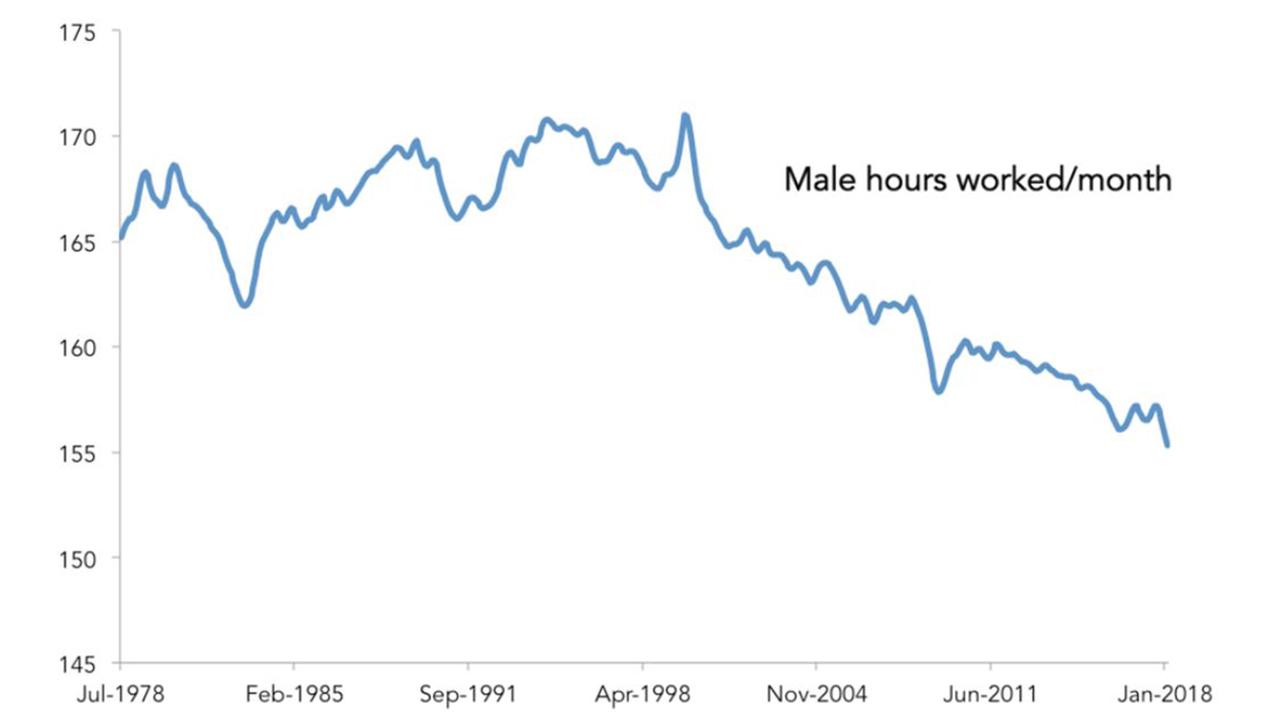Australia’s male employment rates are falling
THE number of hours many of us are working each week has dropped dramatically — but that’s not a reason to celebrate.
AUSTRALIA’S menfolk have never done so little at work. But this is no slacker triumph, and no joking matter.
The number of hours we men put in is now just 155 per month on average. That is less than 36 hours a week — the lowest in the 40 years records have been kept, as the next graph shows.

Since peaking at over 170 hours a month back in 1999, men have been working less and less. Less hours at work means less earnings, and less spending power, and less ability to support a family. The trend away from the old-fashioned male full-time breadwinner shows no sign of stopping.
Are men just making space for more beer and computer games? Unfortunately the erosion of the male working week is not about that. It is to a great extent involuntary, which is why it feels so uncomfortable.
The attack on male working hours is coming from both sides. Not only are full-timers taking the foot off the pedal, (working two hours less each week than they did in 1999), but more and more fellas are working part-time.
Since 1999, the number of men working part-time has more than doubled, to 1.25 million. The number of men working full-time has risen much more slowly, up just 25 per cent in the same period.
When they do work part-time men get fewer hours a month than women, as the next chart shows.

The number of hours part-time workers do has been rising, largely because some full-time jobs have been transformed into part-time jobs, pulling the rug out from beneath people. People who had a secure 40-hours-a-week plus a bit of overtime may now struggle to cobble together 30 hours, sometimes in multiple jobs.
Australia now has a real underemployment problem. The share of people in the labour force who want more hours is 9 per cent — on top of unemployment which is still too high for comfort.
As the traditional idea of a man doing a full-time job gets crushed, underemployment has become the big issue in Australia. But here’s the thing. When we start to look at underemployment, we realise it isn’t a man’s problem at all.
WOMEN WANT WORK
You see a lot of headlines about underemployment these days, but the reality is women have suffered higher underemployment for a long time.
The next graph shows the female underemployment rate is nearly 10 per cent — much higher than for men.

Women want extra hours more than men do!
Women do a very large share of jobs in some of the fastest expanding industries, like health care. And many of those jobs — over 50 per cent in 2016, according to labour market expert Professor Jeff Borland — were part time.
Women wanting more work is not just a statistical issue or a gripe in percentage terms. The numbers are huge. There are 635,000 underemployed women in Australia compared to 472,000 underemployed men.
But do we notice? Underemployment only became a national conversation in the last few years when male underemployment hit the six per cent level which female underemployment was at three decades ago.
Australia’s labour market is evening up as more women take jobs. Australian women are working more than ever, and they want ever more hours. But we still seem to be stuck in a male breadwinner mindset.
Australia’s society is clearly changing quickly. Men who spend less time in the office might be caring for their kids or elderly parents — i.e. doing traditional female roles. That can, in some cases, give their partners more time in paid work.
But what we need to ensure is that these falling hours are a choice — and not something forced upon people. And most importantly, Australian households as a whole need to be working. We need to ensure we have job security and the hours we need to keep a roof over our heads and our families fed.
Jason Murphy is an economist. He publishes the blog Thomas The Think Engine. Follow Jason on Twitter @Jasemurphy




